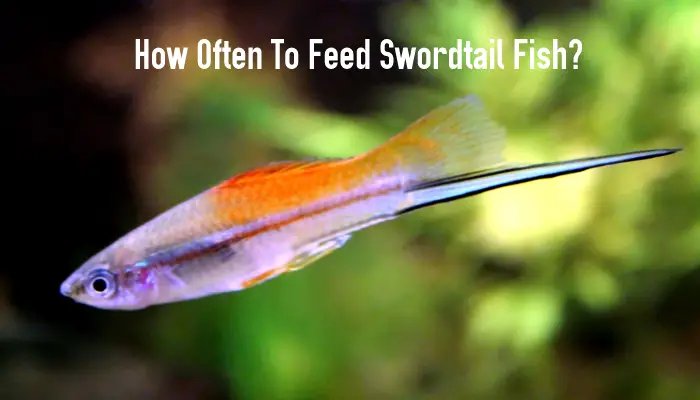
Swordtails, native to North and Central America, are colorful additions to any aquarium. They’re not just pretty faces; they’re active swimmers and quite sociable. Keeping them well-fed goes beyond just tossing in some flakes every now and then. You might be wondering about the best feeding schedule or what kind of food is suitable for them. Don’t worry! I’ll walk you through everything you need to know, from the type of food to a practical feeding routine.
Understanding the Basics of Swordtail Diet
Swordtails are omnivores, which means they can eat both plant and animal-based foods. This flexibility is great because it allows for a varied diet. Think of it like being at a buffet—there are plenty of delicious options! In the wild, they primarily feed on algae, plant matter, small insects, and crustaceans. This natural diet provides them with not only energy but also the nutrients they need.
In your aquarium, replicating this diet is essential. You want to offer swordtails a variety to keep them healthy and lively. A well-rounded diet will help them develop bright colors and robust immune systems. Plus, the right nutrients can lead to longer, happier lives for these charming fish.
Types of Food for Swordtails
When it comes to feeding swordtails, you have a wide range of food options. Here are some of the best types:
- High-quality flakes or pellets: These are often the backbone of a swordtail’s diet. Look for brands specifically formulated for tropical fish.
- Frozen or live foods: Think brine shrimp, daphnia, or bloodworms. These are like a gourmet meal for your fish and can be given a few times a week.
- Vegetables: Fresh or blanched veggies like spinach, zucchini, or peas can be a treat. Just make sure to chop them into small pieces.
- Spirulina flakes: Packed with nutrients, spirulina is excellent for maintaining vibrant colors.
Honestly, mixing these food types not only keeps your swordtails stimulated but also provides them with a balanced nutrition profile. Just keep in mind to avoid overfeeding, as a clean tank leads to happier fish.
Feeding Schedule for Swordtails
Now that we know what to feed them, let’s discuss how often to serve these delightful meals. A good feeding schedule is vital to the health of your swordtails. Generally, you should aim to feed them twice a day. Here’s a simple routine you can follow:
1. Morning: Offer them a few flakes or pellets. Watch them eat. If they finish quickly but seem hungry, you can gradually increase the amount.
2. Evening: Serve a mix of frozen or live food on alternate days. This gives them something special to look forward to.
Remember, each fish is unique. You might notice some swordtails being more active and others more reserved. Adjust the feeding portions to keep their energy levels balanced.
Common Feeding Mistakes to Avoid
While it’s exciting to feed your swordtails, there are some common pitfalls that can harm their health. Here are a few to watch out for:
- Overfeeding: It’s easy to get carried away, but overfeeding can lead to poor water quality and health issues.
- Ignoring variety: Relying too much on one type of food can lead to nutritional deficiencies. Mix it up!
- Skipping plant matter: Omitting greens from their diet can affect their digestive health.
Here’s the thing: swordtails thrive on variety and moderation. Keeping an eye on their eating habits and any food leftovers can help you find the perfect balance for their diet.
Nutritional Needs and Health Considerations
Swordtails require specific nutrients to flourish. Here are some key elements you should ensure are present in their diet:
1. Proteins: Essential for growth and tissue repair, proteins are crucial. Look for food that lists whole fish or shrimp as the first ingredient.
2. Fats: Healthy fats provide energy. Fatty acids like Omega-3 from spirulina or algae are fantastic choices.
3. Vitamins and minerals: These are vital for overall health. B vitamins, vitamin C, and calcium support growth and immune function.
If your swordtails aren’t getting enough nutrients, you might notice dull colors or sluggish behavior. An enriched diet can seriously impact their vitality and lifespan.
Observing Your Swordtails’ Eating Habits
Keeping an eye on how your swordtails eat is super important. They can’t tell us when something’s wrong, but their eating habits can be telling. Here are a few signs to watch for:
– If they’re swimming vigorously and eagerly snatching up food, they’re typically happy and healthy.
– However, if they start refusing food or eating less, it might indicate stress, illness, or water quality issues.
– Pay attention to any signs of bloating or unusual swimming patterns after meals; this could suggest overfeeding.
You might find it helpful to keep a feeding journal for a week or two. Note how much they eat and any behavioral changes. This can help you adjust their diet accordingly.
Final Thoughts on Swordtail Nutrition
Feeding swordtails is more than just a task; it’s an exciting part of your fish-keeping journey. By offering them a balanced diet rich in proteins, fats, and vitamins, you’re supporting their health and enhancing their vibrant colors. Remember, consistency in your feeding schedule and variety in their diet is key.
So, the next time you’re at the pet store, take a moment to think about your swordtails’ meal options. With a bit of planning and observation, you can create an inviting dining experience that will keep them swimming happily in your aquarium for years to come!
